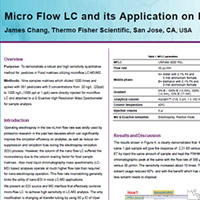
MICRO FLOW LC AND ITS APPLICATION ON FOOD SAFETY ANALYSIS James Chang, Ph.D. Thermo Scientific, 355 River Oaks Pky, San Jose, CA 95134 |
Resumo do Pôster:Micro Flow LC (MFLC)/ESI Q-Orbitrap was explored its applicability for analysis of pesticides using 1/1000 dilution to minimize matrix effects and increase sensitivity. MFLC/ESI Q-Orbitrap can provide low ppt sensitivity and is suitable for this 1/1000 dilution approach and still can achieve the most of regulatory requirement on pesticide within 10 ppb analysis in nine sample matrices. Nano flow LC (NFLC) was widely used for proteomic analysis in the past decades, the sensitivity is increased and as well as the reduction of the matrix effect. NFLC was explored couple years ago for food sample multi-residue analysis in our laboratory. The sensitive was superb, can easily achieved to parts per trillium (ppt) range, however, due to the column capacity and the complication of the sample matrices, the reproducibility of the results were in question and further investigation was needed. With new instrument technology on Micro Flow LC system which provides the need for the sensitivity and robustness on food safety analysis, since it can be shared with the common column packing material such as Hypersil Gold 1.9 um with 1 X 100 mm column or smaller to the 0.32 mm ID column. This study demonstrated that sample dilution is an effective approach to alleviate matrix effects for pesticides co-eluting with low concentration matrix components. Severe matrix effects, however, may still be observed for some pesticides in 1000x diluted samples should concentrations of these co-eluting matrix components are 50- to 100-fold higher than the corresponding/affected pesticides. |
